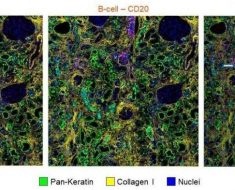
- Salmonella infection causes 420 deaths in the United States every year, and it is the leading cause of blood infection in Africa.
- The infection has links to increased hematopoietic stem cell (HSCs) activity and the production of white blood cells.
- A series of new experiments identifies how resting HSCs help produce mature white blood cells.
- Hematopoietic stem cells of mice with a Salmonella Typhimurium infection contained more fatty acids than those without the infection.
- An increase in the CD36 protein (a surface receptor) was associated with S.typhimurium infection.
- The additional CD36 receptors facilitated free fatty acid uptake to activate the HSCs and provide an energy source.
According to the Centers for Disease Control and Prevention (CDC), 1,35 million people contract a Salmonella infection each year in the U.S., resulting in 26,500 hospitalizations and 420 deaths.
The CDC estimates that foods contaminated with feces transmit 94% of Salmonella infections. Drinking contaminated water and touching contaminated animals can also cause the infection. Symptoms include nausea, vomiting, abdominal cramps, diarrhea, and sepsis.
S. typhimurium causes the majority of non-typhoidal salmonella infections and is the leading cause of blood infection (sepsis) in Africa, associated with fatality rates of 20-25%.
Infection and stem cells
The infection causes an increase in the number of hematopoietic stem cells (HSCs) in the bone marrow.
HSCs are responsible for hematopoiesis, a process that forms all types of blood cells: platelets, red blood cells, and white blood cells to help the body fight the infection. Scientists do not fully understand how infection causes hematopoiesis.
HSCs are generally inactive, but when infection occurs, they respond quickly, increasing the number of white blood cells. Studies have shown that activated HSCs use free fatty acids from the body’s fat stores as energy to respond to infection.
Fatty acids as an energy source
Fatty acids are the building blocks of the fat in our body. All fats play important roles in the body, but some fats are better than others for long-term health. Some research has linked infection to an increase in free fatty acids in the blood.
A study led by Dr. Stuart Rushworth, Associate Professor, Norwich Medical School, University of East Anglia in the United Kingdom, demonstrated higher levels of free fatty acids in the blood of mice 72 hours after infection with S. typhimurium.
The study — published in nature communications — highlights the activity of HSCs in mice infected with S.typhimurium. The number of HSCs increased 72 hours after infection and contained more fat than the HSC of non-infected mice.
The results suggest that HSCs can use free fatty acids to generate energy to support the increased cellular activity during bacterial infection.
“Fighting infection takes a lot of energy, and fat stores are huge energy deposits, which provide the fuel for the blood stem cells to power up the immune response,” notes Dr. Rushworth.
Fatty acid uptake mechanism
CD36 is a protein found on the surface of HSCs that moves free fatty acids inside the cell. Once inside the cell, they travel to its “powerhouse,” the mitochondria, where the cell uses the free fatty acids to make the energy.
In the study, the researchers pre-treated the mice with a CD36 inhibitor before infecting them with S. typhimurium. HSCs from the CD36-inhibited mice had lower levels of free fatty acids and lower activity levels and could not increase the number of cells necessary to respond to the infection.
Post-doctoral researcher Dr. Jayna Mistry tweeted: “We show Salmonella infection drives fatty acid uptake by HSCs, an essential process in the immune response to infection.”
Speaking about the future of the work, Dr. Rushworth says, “I hope our findings will help improve treatment for vulnerable and older people with infections by strengthening their immune response.”
The research gives a clearer understanding of how HSCs behave in the bone marrow when the body fights infection, which may also lead to alternative treatments for bacterial infections.
Source: Read Full Article





